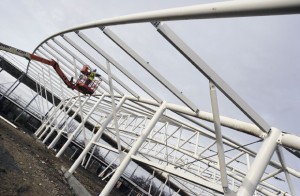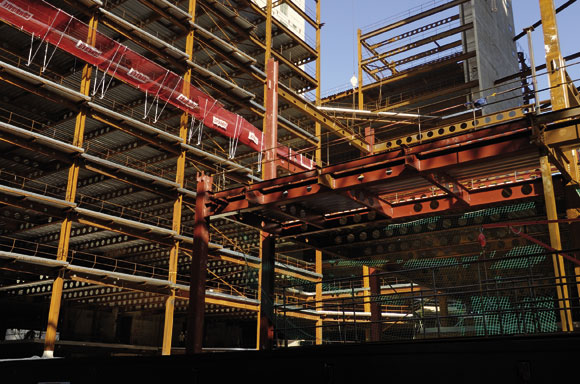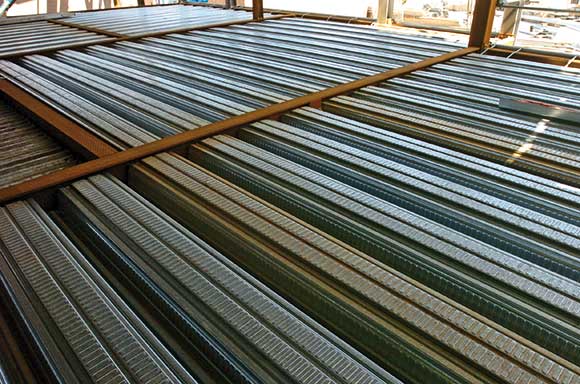Technical
The case for steel – Specify steel – specify quality

Systems, such as the Easi-edge protection on this hospital project in Sunderland, are routinely put in place during steel erection
Our series on the Case for Steel continues with Nick Barrett outlining why choosing steel construction is the quality option.
Steel as used for framing solutions in the majority of the UK’s new buildings is one of the most quality assured products available anywhere. This assurance of quality runs from the sourcing of the raw materials used in steel production, through manufacture of steel at Corus owned UK steelworks, into factory controlled conditions of the steelwork contractors’ fabrication workshops and onto erection on site. With steel, quality is built in, right along the supply chain.
Selection of steelwork contractor
The quality process for steelwork fabrication and erection starts with the selection of a steelwork contractor properly qualified to undertake the projects selected from the Register of Qualified Steelworkers.
The steelwork fabrication process also delivers quality certainty as it is typically driven by a seamless link between the 3-D model and numerically controlled fabrication machinery. The steelwork production process means that close cooperation between client, designers and steelwork contractors is easily achieved; when required, structural solutions can even be trialled before going to site using mock ups, as Severfield Rowen did for client BAA at Heathrow’s soon to be opened Terminal 5. Production of steelwork to the tight tolerances made possible by these processes means steel is delivered to site with minimal defects, and hence there are fewer problems during the crucial on site phase of developments. Steelwork production in line with the National Structural Steelwork Specification helps ensure that steelwork will be accurately, economically and safely built.
The quality of steel construction is seen clearly when steelwork erection gets underway on site. The speed and trouble free nature of erection can surprise those unused to seeing the benefits of steel at first hand. Steelwork is erected by fully trained and highly competent operatives, following best practices that are published in comprehensive safety codes of practice by the BCSA.
Steelwork contractors have developed and shared many innovative safety related systems, such as edge protection systems, that help explain why the steelwork sector has a safety record that is the envy of the rest of the construction industry.
Quality seen on site
Steelwork is not affected by the usual UK weather and special protection measures are only required when temperatures fall to unusual levels. There is a wide range of industry guides for the erection of different types of structures. Once erected, a steel frame is a durable product, not subject to creep or shrinking like other materials. Proven corrosion protection systems are available for use where harsh environments demand them. Most steelwork contractors have comprehensive certification of their operations through schemes such as the Steel Construction Certification Scheme.
In service, steel is strong and ductile and proves its quality characteristics by its resistance to accidental damage. Sections of steel can easily be replaced if required by either cutting, welding or bolting to restore full resistance with a solution that is predictable and assured. The quality of life of a steel frame can be extended as a steel framed building lends itself to easy extension and adaptability to changing uses.
The durability of steel has been long established; piles that have been extracted from the ground after being there for 100 years have been found to be in good enough condition to be re-used – all steel is of course fully recyclable as well. Piles extracted from the ground in Chelsea in 2006 were so well preserved that the rolling marks and the name Frodingham could still be seen, confirming that they were produced in Scunthorpe in 1907.
More is known about the performance of steel in the harshest of conditions – fire – than any other material. The quality of the material and the designs that it allows is such that fire regulation requirements are easily achieved. Advances in structural frame analysis are still advancing, increasing our knowledge of the performance of structural steel frames in real fires, allowing improvements in economic design for fire conditions.
Aesthetic quality
For many people the quality of a building or other structure is most clearly seen in its finished appearance, and it is here that steel allows major benefits to be shown. Steel is increasingly seen as the aesthetic choice for structures as it allows architects free rein to express their vision. Steel can be curved in three dimensions, bent to almost any shape architects can envisage. Tubular steel has become almost the default choice for large external trusses in sports stadiums as a result. Tubes are also increasingly used as the main structural columns for prestige office buildings such as the Wellcome Trust’s corporate headquarters in London.
A comprehensive range of structural plate grades is available to the UK market, including weathering steels as well as a complementary range of sections. The bridge market is a key user of these products and steel has recently made inroads to parts of the bridges market traditionally left to concrete, such as shorter span road bridges.
Weathering steels have been used recently on some high profile road bridge projects and are being specified by architects and engineers as well as being requested by clients for their aesthetic properties. They are a quality solution for a wide range of outdoor applications for structures in exposed locations. Durable painted protection systems have been specially developed for locations where such a finish is required.
Advance a guarantee of quality
All structural steel sourced from Corus is CE marked, which gives an assurance that Corus steel is of guaranteed quality and of a provenance that can be confidently demonstrated
Corus has recently invested heavily in its plant and delivery systems to ensure the continuing delivery of quality products, including over £200M of improvements at its Scunthorpe long products site. The latest in steel rolling technology has been installed at the Medium Section Mill to create the world’s first dual rail and structural sections rolling mill. Corus’ Advance sections range benefits from this quality enhancement.
The new facility can produce structural sections to the most demanding specifications, well inside the minimum requirements set by national and international standards for dimensional tolerance and material performance. Corus’ tight manufacturing controls also enable production of bespoke sections where depth and flange/web thickness of a section can be tailored to the particular needs of a project.
The investments also include the construction of a new world class Automated Distribution Centre (ADC) at Scunthorpe, which will receive Advance sections from the adjacent mill and stack and retrieve them as required while sheltered from the elements. The ADC improves customer service by ensuring that all products are despatched on time and reach customers in first class condition.
Corus was the first steelmaker in the world to gain approval to CE mark its structural sections and plates to meet the EU Construction Products Directive (CPD). Advance sections were the first in the world to be accredited under the onerous Lloyds Register marine quality scheme, and Corus is one of a very small number of manufacturers outside Japan to carry approvals from the Japanese Institute for Standardisation.
In 2006, to make it even easier to specify Corus CE marked sections compliant with the CPD, Corus introduced Advance as the new name for its entire range.
The name Advance was chosen to reflect the many technological improvements and the well-established world-class processes involved in producing Corus structural sections. Manufacturing excellence is assured for steel with the Advance sections mark.
Designers need to be sure that sections they specify comply with the CPD, and choosing a CE marked product is the simplest way to achieve this. The Advance range includes all section types (channels, angles and bearing piles as well as beams and columns), all with the Advance mark rolled into the web for ease of identification and traceability.
At the same time 21 new beams and columns were added to the ‘traditional’ UK section range to increase the flexibility that steel offers designers to achieve the most effective structural solution.













